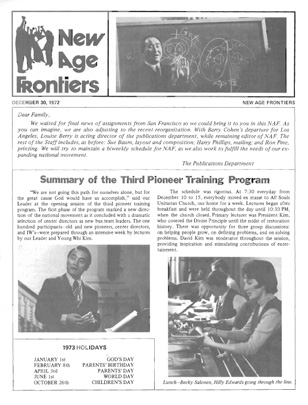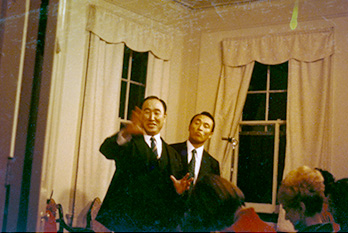Hectic Four-day Training in Washington, D.C in 1972 Left its Imprint
 |

Rev. Moon (right) and Young Whi Kim (left) at the Upshur House, Washington, D.C. (Photo courtesy of Louise Perlowitz) |

According to Dan Fefferman, “Unificationists did a lot of singing back then… This photo of the group singing in Upshur House catches this spirit.” (Photo courtesy of Louise Perlowitz), Top row left to right: Ron O'Keefe and Neil Winterbottom. Next row: Barbara Reem, Mike Leone, Kathy Goldman (Novalis), Sandra Singleton (Lowen), Dan Fefferman, Elena Barros (Decker) |
During the holiday season of 1972, young Unificationist David Hill attended the first day of a four-day training program in Washington, D.C. that he never forgot. Forty years later, even though most of his vaulting hopes and idealistic expectations were not fully met, he and some of his fellow members at the time agree it was an exciting time period and one they were happy to remember.
In retrospect, historians tracking the rise of the Unificationist movement will likely note that Rev. Sun Myung Moon’s personal, passionate and demanding training of 100 church members that month laid the foundation for dramatic growth for the Unification Church in the coming year.
A newsletter created by early Unificationists called the “New Age Frontier” (NAF) provides context for the setting of the unpublished speech from December 10, 1972 that David Hill kept safe on a cassette recording and that he offered to Unificatonnews.com in September of 2012. The NAF newsletter, published December 30, 1972, includes a quote from the sermon Rev. Sun Myung Moon gave at the Upshur House Center: “Which is first? Love or Life? Man was born out of love… You must live and die in love… If you pour yourself out to a person, that person will be yours. Who has given out everything? God. If people really know that God is like that, they cannot but love Him.”
Louise (Berry) Strait, then editor, writer, photographer, etc., of the NAF, told Unificationnews.com, “I’m amazed that I even got to one of the speeches to write up notes.”
According to Strait and the NAF newsletter she created in late December of 1972, Unificationists in Washington, D.C. held the “Third Pioneer Training Program” from December 10 to 15, 1972. Before the daily training sessions, Rev. Moon spoke almost every morning and these morning sessions would include a lot of singing. “We did a lot of singing back then,” wrote Unificationist Dan Fefferman to Unificationnews.com. The morning of December 10, 1972, Rev. Moon spoke three hours at the Upshur House basement.
It was during this training program that Rev. Moon established state leaders and created bus teams. Fefferman said, “It was about this time when the movement began to take on a unified character.”
The Unificationists of 1972 were determined for social change. “We were very idealistic and enthusiastic to be led by True Father directly,” said Fefferman. “We would basically do anything Father asked us to. Everyone was ready to go anywhere and work with almost anyone at the drop of a hat.”
Fast-forward 40 years: The expectations some Unificationists had when they were younger were not completely fulfilled. Hill said, “In many ways now we are back to where we started 40 years ago.” Yet he and other Unificationists, like Fefferman and Strait, were happy to be a part of the exciting early church growth and tell Unificationnews.com that they hope the next generation of Unificationists can build upon previous work and foundation.
When Fefferman was a young Unificationist, he expected a major transformation of America. However his expectations were not met. “As exciting as the time was, with hindsight I think we [the church] would have done better to stick with the church center system rather than focus on the mobile teams,” Fefferman explained. “We used to be students or work at non-church or ‘outside’ jobs for the most part, and donate money to the centers. But once One World Crusade (OWC), International OWC and Mobile Fundraising Team (MFT) started up, that changed. We all became full timers. Students were pushed to drop out of school. No one developed a career in the ‘real world.’ So we were not equipped for married life, and our church economy was based exclusively on fundraising rather than tithing. Once large number of Unificationists were Blessed and started having families, the church couldn’t sustain itself. Moreover, [after 1982] members were no longer joining in large numbers, because our church culture had become one of outsiders, organized along Japanese disciplinary lines, rather than part of the youth scene.”
Hill said of the past 40 years, “In many ways, we are back to where we started.”
Strait said her expectations, like Fefferman’s, were not met, “Maybe my expectations were unreasonable, but a lot of mistakes were made, also. One was having an Asian model superimposed on us. And the theme of dropping out of everything served not only to isolate Unificationists from the rest of society but [that] fueled suspicion against us.”
“Looking back, I think we reached too high,” Fefferman added. “We peaked too soon. We were greedy for money and members. All with good purpose, of course. Nevertheless, it sure was exciting while it lasted! I am so happy to have been a part of it. And I do think we have left an important legacy for the next generation of Unificationists to build on. Even if we did not save the world, a person could do a lot worse with his life than to help found a new world religion, even a small one.”
David Hill and other Unificationists, who have been in the church for 40 years, will be honored after the main worship service in Maryland December 9, 2012. The full speech “The Point of Rise or Fall” will be published and handed out to the celebrants.
by Krista Karjalainen from New York.